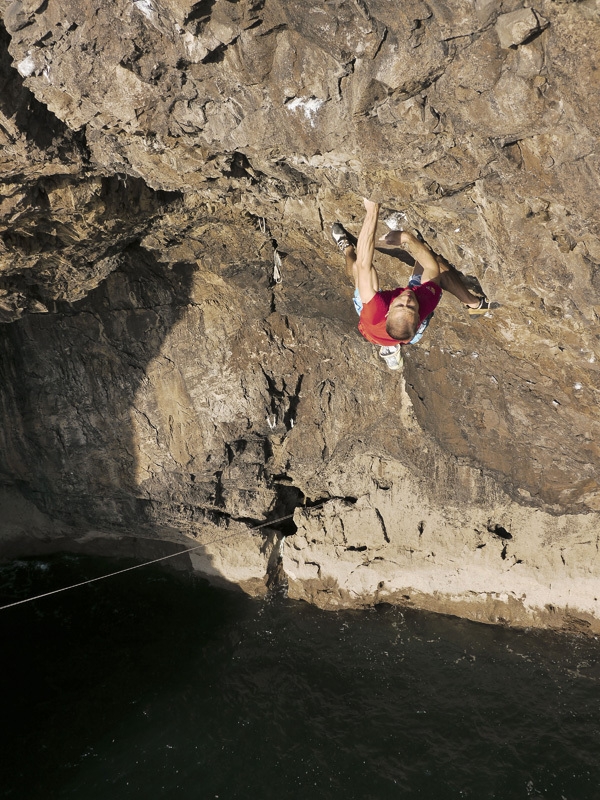Neil Gresham, Hydrotherapy Deep Water Solo in Pembroke
Deep water solo usually conjures up images of sun-tanned climbers battling it out on sun-kissed limestone high above the warm Mediterranean sea in Mallorca and while this small island is undoubtedly the world's premier DWS venue, few realise that there are equally stunning lines dotted around Great Britain, albeit with a significantly colder drop.
One of Britain's most talented climbers, Neil Gresham, has slowly but surely been exploring the country's potential and recently came up trumps with Hydrotherapy, at 8a+/S2 one of the hardest of its kind in Great Britain. The route is located at Hollow Caves Bay in Pembroke, to the right of Ben Bransby's unrepeated trad E7 Underworld and to the left of his own's DWS Submariner (7b+/S1) which he established last year.
Gresham climbed Hydrotherapy over a period of 2 days after having worked the route on abseil and apart from the pure difficulties, other important access variables need to be born in mind: the route is located in an area often closed for military exercises, the cave only dries out during the last hours of daylight and, last but not least, it requires spring tides to ensure deep water for a safe landing. Gresham explains as follows:
HYDROTHERAPY
by Neil Gresham
Hydrotherapy required more effort and determination than any other DWS that I have climbed before. It totals about 100 feet in length, 20 feet of F6a, followed by 40ft of sustained 8a+ climbing, followed by another 40 feet of F6a. I fell twice prior to doing the route (spread over 2 days) - both falls were from the second crux which is a powerful undercut move at about 50feet. It is safe to fall at any point on the route, apart from the last easy section, which is probably a bit too high!
The route requires Spring tides and the evening window is the only option. The cave stays wet from condensation during the day and requires afternoon sun to dry it out. As a DWS venue, it couldn't feel more different to somewhere like Lulworth, Conner Cove, or even Diablo in Majorca. The cave has a big and serious feel to it, so you need to check your conditions and be pretty psyched.
Hydrotherapy would be possible as a trad route (estimated grade E9 6c/7a) but the amount of faffing around would make it even more of an epic to attempt. The water is only low enough for an hour or two with low Spring tides, and after that you would be stranded in the cave. In spite of the fact that I worked the route on an abseil rope, I'm still massively attracted to the purity of a DWS ascent. With trad, after you fall you always need to leave a minimum amount of gear in place in order to lower off, so you end up questioning your ethics and wondering whether or not you've actually done the route! With DWS it's pretty clear-cut.
As to the S Grade, in short this can be summed up as follows:
S0 short (eg: 10 - 40ft) with a broad tidal window.
S1 a bit higher but safe (eg: 40 - 50ft). Relatively broad tidal windows
S2 higher still (eg: 50-65ft) or lower but with a narrow tidal window
S3 Very high, (eg: 65 - 80ft) or lower but with a very narrow tidal window (or possibly above shallow water even with high springs)
| Planetmountain | |
| News Neil Gresham | |
| Climbing at Huntsman's Leap, Pembroke | |
| Expo.Planetmountain | |
| Expo Black Diamond | |
| Expo La Sportiva | |
| www | |
| www.neilgresham.com | |



 1 / 1
1 / 1
 Copia link
Copia link

 Liam Cook
Liam Cook






















